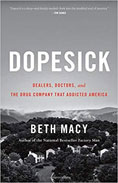
 |
Dopesick: Dealers, Doctors, and the Drug Company that Addicted America
by Beth Macy
Little Brown
Lately, it appears that it’s women doing real journalism in America. Whether it’s Sharyl Attkisson fighting for truth in reporting or Sarah Carter exposing corruption in the US Justice Department, they dig for facts to reveal the salient story. Now it’s Beth Macy’s turn. Hardly her first dive into a story, Macy plumbs the depths of the country’s very sad and particularly dangerous opioid epidemic. It’s a compelling and necessary read. And, by the way, all three women deserve a Pulitzer Prize nomination at the very least.
Macy’s Dopesick begins within the offices of a powerful corporation—Purdue Pharma—which suppressed the addiction rates of their super new painkiller OxyContin and hyper-marketed it throughout the medical community. Their plan was shrewd; their aspirations ruthless and profits large. Addiction came easy. Suddenly cutting off a patient’s prescription was no longer a solution. Logic isn’t a part of an addict’s brain; it’s been reconfigured by the drug. Sooner than later, people spilled onto the streets for a fix, and chaos ensued.
At the turn of the century, in places like the rural and economically collapsed communities of Appalachia, where Macy devotes most of her story, illegal opioid use blossomed, out of view from the rest of the country. However, sophisticated drug dealers in the cities had witnessed spikes in demand before, and the country folk wandering into town for large supplies of heroin was a rainmaker clue. Aided by the interstate highway system, profiteers organized networks of user-dealers to supply the burgeoning black market. The problem quickly transformed into a hydra. Police couldn’t keep up with the addicts committing crimes to feed their need. Families lost loved ones, barely recognizing the problem until it was too late. Hospitals were ill-prepared for this new wave of disease. The courts were outdated in their approach, as well. People from all walks of life suddenly began dropping dead.
Many factors go into the making of a widespread addiction: poverty, desperation, ignorance, greed, and plain bad luck. This modern opium war knows no boundaries. Your next door neighbor, for example, gets an injury, takes painkillers at the advice of a physician, and within weeks—sometimes days—he’s addicted. This is not your casual drug user who gets in over his head story, although there are plenty of those people in this group, too.
Where will this end? Right now, almost 60% of the population knows someone touched by this epidemic, and it’s the leading causes of death among people under the age of fifty. Do we want this to get any worse? And who will stop it? Can we stop it? You may think you’re safe, but wait until next year or even next month. This reviewer lives in an upper middle class east coast community, and he’s heard the stories of opioid addiction from his children and the people he knows. The next historical heroin addiction event is no longer knocking at the door. That was a decade ago, as Macy aptly documents. It’s potentially inside our homes now.
Heavily footnoted and deeply researched, Macy plots the course of disaster for the United States, and we haven’t seen the worst of it yet. On one side, pain management is a legitimate medical course of action, but that's only part of the issue. Heroin addicts become dope fiends who will do just about anything to feed their habit and avoid the overwhelming “dopesick” feeling of withdrawal. They are good people sucked into a tornado, some by accident, some through ignorance. Spending every dollar, losing every accomplishment, and destroying every relationship appears just a matter of course, and then things get worse. The only hard stop to their fall seems for many to be death. Otherwise, the recovery process is long and fraught with pitfalls and relapses, and the best cures involve alternate prescription opioid intervention.
Considering the fine research and execution within this book—it took Macy five years to write it—one can only conclude that journalism isn’t so much tarnished by fake news, as it is by reporters who refuse to do real work. And there are so many lazy, deceptive reporters afoot. Beth Macy of course is not among their ranks. Her work is vital to the future of an addicted country. She takes you inside with authenticity and compassion—the two very best skills of a modern journalist. She doesn’t have to embellish or thrust her opinions upon us. The facts are bad enough.
RECOMMENDED by the US Review
Next Focus Review
Previous Focus Review